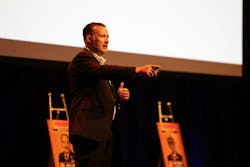FireFusion 2025: Embracing Smart Cities Allows Fire Departments to Understand, Improve Service
The second day of FireFusion 2025 kicked off with Fire Chief Dan Munsey talking about the need to be innovative, despite a proud history of tradition in the fire service. The fire service, Munsey said, is innovating everyday.
Munsey, of the San Bernardino County, CA, Fire Protection District, talked about innovation through the smart cities movement, giving attendees his department’s roadmap into those initiatives.
Munsey advocated for eradicating the age-old saying of the “fire service is 250 years of tradition.” The reason behind wanting to eliminate that saying is that the fire service is ever-changing and there is proof that operations haven’t changed in those hundreds of years.
“Did you know the fire service is the second-slowest adopter of technology? People say it’s always worked, so we’re going to keep doing it that way. Nothing’s changed in the fire service, except for everything,” said Munsey, during this keynote address.
With new technology coming out at an exponential rate, more studies and more statistics, it is self-destructive to stay set in those old and traditional ways. Emerging technology allows the possibility of integration of that public safety technology into smart city initiatives.
What is a smart city and why is it needed?
A smart city uses digital technology to improve the quality of life for its citizens by enhancing city services and infrastructure. It collects and analyzes data from sources like Internet of Things (IoT) sensors and cameras to optimize urban areas, leading to benefits like improved traffic flow, efficient energy use, improved public safety and more responsive services.
Munsey highlighted that the fire service is starting to understand the importance of data, however, there needs to be more utilization and analyzation of that data to make a difference.
“A smart city capitalizes on that concept that one of the greatest resources that our community has is the data we can collect,” said Munsey.
A firefighter’s number one job is to prevent harm and Munsey said they should be using technology to keep citizens safe. The technology can track every person in every room in a building, it can show detection systems, sprinkler systems and other system statuses. With all that information, Munsey asked, why isn't the fire service taking advantage of it?
Munsey brought up a recent call from Amazon saying it has delivery drones ready to be utilized, but with the older technology San Bernardino has, it creates issues within the airspace.
“Public safety must be ahead of the smart city curve,” said Munsey. “Right now, you are on the cusp of being able to lead the fire service into the newest generation and get out ahead of the Amazons,” said Munsey.
Connectivity is key
“If we’re not able to connect our firefighters and our fire engines, then we’re not going to be able to use modern technology,” said Munsey while conveying how important it is to create mesh networks, redundancies and fail-safes.
There is a means to fully utilize traffic preemption and vehicle alerts to get citizens safely out of the way of an emergency response and that’s when Munsey mentioned ArcGIS mapping and how it can be pivotal in operations. The integration of these technologies is key, he said.
“We need to be integrated in common operating pictures and common operating platforms,” said Munsey. “We need to use this technology to create better citizen engagement, better communication.”
Sustainability, mobile enhanced transportation and shared data schemes
Munsey touched on how, at the California fire service resource sharing group FIRESCOPE, there was the creation of a fire technology map that broke down each technology into a category of liveware, hardware or software. The complication happens, Munsey said, when all those boxes in the map are siloed data.
“We spent millions of dollars connecting 11 different CADs together through a hub. All we did was network computers together," said Munsey. "That’s a 1970s solution. It’s moving away from hard drives and putting our information in the cloud and combining smart data from smart cities in the cloud. If we can do that, we can standardize our data."
From there, other data sets and programs can be integrated to bolster the overall knowledge on the scene to create common operating pictures. Munsey refers to how his department hired a fire futurist to focus on 20 years down the road. A technology plan was created that was centered on strategic technology initiative goals.
“We have to think about how we are going to get there,” Munsey explained.
He outlined the four pillars that enable the adoption of technology: culture, training, infrastructure and re-imagining budgets. That's where the technological plan comes into play.
“You have to be succinct in your vision. You need to communicate that vision,” said Munsey.
While outlining those four pillars, Munsey emphasized that partnerships are relationships and that leads to innovation. He refered to how he got into business with Microsoft, Insight and the Western Fire Chiefs Association to build a public safety cloud partnership.
Munsey stressed that the fire service need to get in line with that technology that is available today and in the future to maximize the data that is collected.
About the Author

Ryan Baker
Ryan Baker is a writer and associate editor with prior experiences in online and print production. Ryan is an associate editor for Firehouse with a master's degree in sciences of communication from the University of Wisconsin-Whitewater. He recently completed a year of teaching Intro to Public Speaking at UW-Whitewater, as part of his graduate program. Ryan acquired his bachelor's degree in journalism in 2023 from UW-Whitewater, and operates currently out of Minneapolis, MN. Baker, also writes freelances for the Ultimate Frisbee Association (UFA) in his free time, while also umpiring baseball for various ages across the Twin Cities Metro Area.
